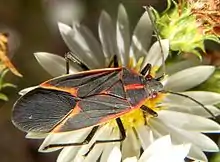Boxelder bug
The boxelder bug (Boisea trivittata) is a North American species of true bug. It is found primarily on boxelder trees, as well as maple and ash trees.[1] The adults are about 12.5 millimetres (0.49 in) long with a dark brown or black colouration, relieved by red wing veins and markings on the abdomen; nymphs are bright red.[2] This species recently invaded Chile, thus becoming an invasive species.[3]
| Boisea trivittata | |
|---|---|
 | |
| Scientific classification | |
| Kingdom: | Animalia |
| Phylum: | Arthropoda |
| Class: | Insecta |
| Order: | Hemiptera |
| Family: | Rhopalidae |
| Genus: | Boisea |
| Species: | B. trivittata |
| Binomial name | |
| Boisea trivittata (Say, 1825) | |
| Synonyms | |
|
Leptocoris trivittatus | |
Etymology
Trivittata is from the Latin tri (three) + vittata (banded).
Biology and taxonomy
Boxelder bugs feed almost entirely on the developing seeds of boxelder, maple, and ash trees.[1] The boxelder bug is sometimes confused with insects belonging to the genus Jadera, and with the western boxelder bug (Boisea rubrolineata) which it is related to. The name "stink bug," which is more regularly applied to the family Pentatomidae, is sometimes incorrectly used to refer to Boisea trivittata. Instead, boxelder bugs belong to the family Rhopalidae, the so-called "scentless plant bugs". However, boxelder bugs are strong-smelling and will release a pungent and bad-tasting compound upon being disturbed to discourage predation. This allows them to form conspicuous aggregations without being preyed on.[4] These insects feed, lay eggs and develop on boxelder trees, most commonly occurring on female trees as they produce seeds. Boxelder bugs prefer seeds; however, they also suck leaves. They can be frequently observed on maple as these trees provide them with seeds as well. Boxelder bugs overwinter in plant debris or protected human-inhabited places and other suitable structures.
As pests
Although they specialize on the seeds from maple, boxelder and ash,[1] they may pierce other parts of the plant while feeding. They are not classified as an agricultural pest and are generally not considered injurious to ornamental plantings.[5] However, they are known to damage some fruits in the fall when they leave their summer quarters in trees and seek areas to overwinter.[5] Feeding by the bugs produces dimples, scars, fruit deformation, corky tissue, and even premature fruit-drop in strawberries and some tree fruits.[5]
During certain times of the year boxelder bugs cluster together in large groups while sunning themselves on warm surfaces near their host tree[5] (e.g. on rocks, shrubs, trees, and man-made structures). This is especially a problem in the fall when they are seeking a warm place to overwinter.[5] Large numbers are often seen congregating on houses seeking an entry point.[5] Once they have gained access, they remain inactive behind siding and inside of walls while the weather is cool. Once the home's heating system becomes active for the season, the insects may falsely perceive it to be springtime and enter inhabited parts of the home in search of food and water. Once inside inhabited areas of a home, their excreta may stain upholstery, carpets, drapes, and they may feed on certain types of house plants.[5] In the spring, the bugs leave their winter hibernation locations to feed and lay eggs on maple or ash trees. Clustered masses of boxelder bugs may be seen again at this time, and depending on the temperature, throughout the summer. Their outdoor congregation habits and indoor excreta deposits are perceived as a nuisance by many people, therefore boxelder bugs are often considered pests.[5] However, boxelder bugs are harmless to people and pets.[5] The removal of boxelder trees and maple trees can help control boxelder bug populations.[5] Spiders are minor predators,[5] but because of the boxelder bug's chemical defenses few birds or other animals will eat them.[5] Boxelder bug populations are not affected by any major diseases or parasites.[5]




 Mating small milkweed bugs (Lygaeus kalmii) in Lockport, New York. Sometimes confused with boxelder bugs.
Mating small milkweed bugs (Lygaeus kalmii) in Lockport, New York. Sometimes confused with boxelder bugs. Large group of boxelder bugs found on a fallen limb.
Large group of boxelder bugs found on a fallen limb. A mass of boxelder bugs on a fencepost in Bolton, Ontario in September 2018.
A mass of boxelder bugs on a fencepost in Bolton, Ontario in September 2018.
References
- Boxelder Bugs University of Minnesota Extension
- Göllner-Scheiding, U. (1983): General-Katalog der Familie Rhopalidae (Heteroptera). Mitt. Zool. Mus. Berlin 59, 37–189.
- Faúndez, Eduardo I.; Carvajal, Mariom A.; Sarmiento, Carolina (2020). "Detection of the boxelder bug Boisea trivittata (Say, 1825) (Heteroptera: Rhopalidae) in Chile". Heteroptera Poloniae – Acta Faunistica. 14: 125–126. doi:10.5281/zenodo.3934435.
- Aldrich, J.R.; Carroll, S.P.; Oliver, J.E.; Lusby, W.R.; Rudmann, A.A.; Waters, R.M. (1990). "Exocrine secretions of scentless plant bugs: Jadera, Boisea and Niesthrea species (Hemiptera: Heteroptera: Rhopalidae)". Biochemical Systematics and Ecology. 18 (5): 369–376. doi:10.1016/0305-1978(90)90010-D.
- Roe, Alan H. (April 2000). "Boxelder Bugs Fact Sheet No. 41" (PDF). www.extension.usu.edu. Utah State University Extension. Archived from the original (PDF) on 2018-04-27. Retrieved 27 April 2018.
External links
 Media related to Boisea trivittata at Wikimedia Commons
Media related to Boisea trivittata at Wikimedia Commons- Box Elder Bug – large format photos and information